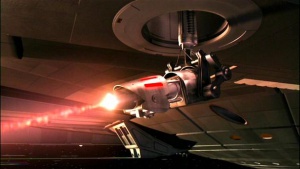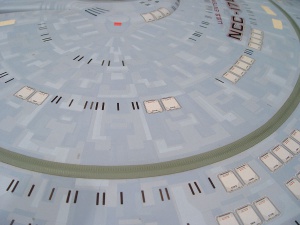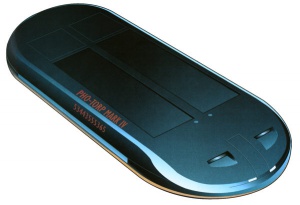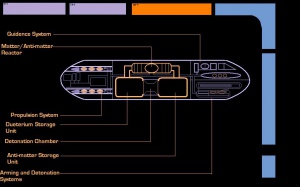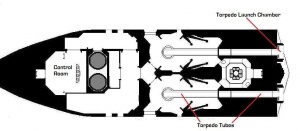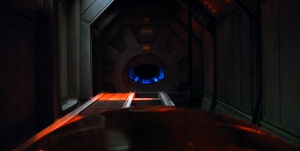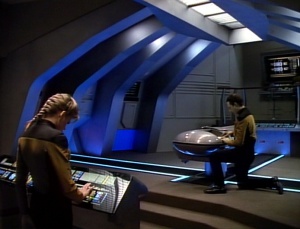Starship Weaponry
Contents
Introduction
Please note: This paper does not represent the official Star Trek canon on starship weaponry. However, this is official, Federation Space, weapons specification canon.
Phasers General:
Phasers, short for Phased Energy Rectification Device, are easily the most commonly used weapons throughout the known galaxy. Variations of the Phaser are installed on warships of all major races in the galaxy. Though there are variations, all Phasers can be grouped into four types.
Types of Phasers:
- Type I Phaser (Offensive): The most powerful, ship mounted, Phaser, it’s the standard main Phaser for the Federation, Romulans, Gorn, Cardassian, and Tholian militaries.
- Type II Phaser (Offensive/Defensive): Less powerful than the Type I, the Type II requires roughly half the power. Designed by the Klingons (and stolen by the Mirak) to counteract the missile threat of the Mirak, the Type II became the all-purpose standard for the Imperial Klingon Navy. Not long after, the Type II began appearing on Mirak vessels. The Type II Phaser is used almost exclusively by the Klingon and Mirak Navies, though it’s not uncommon to find them mounted on Orion pirate ships.
- Type III Phaser (Defensive): The Type III Phaser has come into wide spread use with the introduction of fighters and has become part of the defensive weapons of most starships. The Type III only requires ¼ the power of a Type one Phaser, allowing continuous rapid-fire against targets. Though they were designed to destroy enemy torpedoes and small craft, they have found other uses as well.
- Type IV Phaser (Heavy): This huge Phaser is only mounted on large bases and occasionally planetary defense grids. Two or three blasts from a Type IV Phaser could easily destroy a heavy cruiser sized ship.
- Phaser-G (Gatling): A newer design first implemented aboard the Defiant-class, the Phaser-G is a multi-purpose Pulse-Phaser than can fire with the destructive potential equal to a standard Type I Phaser. In trial tests, the Phaser-G has proven successful as both and offensive and defensive solution. Some Gatling Phasers have been "spiked" to allow them to fire at an increased rate, but this depletes the power cells faster and shortens the operational lifespan of the emitter due to the extreme temperatures involved. The Gatling Phaser is currently standard armament on Star Fleet Fighters, Federation-class Carriers and the Cicero-class Support Escort.
Phasers on Star Fleet ships/installations:
While the concept has remained the same, the delivery method of Phasers have changed significantly over the centuries, ranging from cannon type devices as seen on the Enterprise NX-01 and USS Defiant, to banks found on late 23nd century starships such as the Miranda class and Excelsior class starships, to arrays found on many late 24 century starships such as the Galaxy class and Sovereign class. Currently, in the 25th century, technological updates and necessity have brought Star Fleet back to the use of banks.
Differences:
- Phaser cannons: The technology for this has been around for centuries. In its infancy, Phaser cannons were used primarily because technology hadn’t developed enough to downsize the device. However, as technology increased, and parts were downsized and made to handle power loads more efficiently for their size, Phaser cannons saw a brief comeback. These were seen on the Defiant class starships. Phaser cannons on the Defiant-class (Pulse Phaser Cannons) saw use because of the sheer amount of energy that could be channeled to them because of the modern day size of the components, a pulse was required however to allow the cooling systems to prevail and prevent immediate burnout of the cannons. The configuration and layout of internal power distribution of the ship itself allowed this use of this technology, and is still impractical on standard Star Fleet design methods due to the limited firing arc and the power requirements.
In extreme cases a photon launcher system on a starship can be completely rebuilt to house a Phaser cannon, but due to shutting down a torpedo launcher, practicality, and the power load/drain required, use is not common.
- Phaser banks: Phaser banks are a group of Phaser emitters grouped together into one centralized location. They share a common power source, the warp core, but separate power relays and recharge unit. Normally multiple emitters are fired simultaneously giving the illusion of 1 Phaser strike. While firing emitters simultaneously allows more firepower to be delivered, the setback is those emitters would be out of use while they recharged.
While still commonly used on more dated starships for a longer period of time, overall incorporation of it into newer class starships was abandoned for nearly 100 years after the invention of the Phaser array, but has found use once again.
- Phaser arrays: This technology was largely seen in the latter half of the 24th century on such ships as the Galaxy -class, Intrepid-class, Sovereign-class ship to name a few, all the way up until the first General War. Phaser arrays allow the power to be channelled and released anywhere along the array, and in some cases at multiple points at the same time; this however had the effect of requiring twice the power drain. The benefits of the Phaser arrays were that this technology allowed a much larger firing arc than just one bank. Another befit was that the focal point of the energy could be shifted along the Phaser bank which allowed the release of the energy at different points without compromising the size of the Phaser arc; this prevented anyone section from experience component burnout. The downfalls of this technology were discovered during the first general war where enemy ships would focus their fire on to the Phaser array. Because the technology is dependent on a large section of the array to be operational, this allowed a much larger target area to disable that section of the array; also of this, one well-placed hit could potentially disable two sections rather than just one. Another setback to this technology was that the whole array had to be of the same type; with the additional space taken up by the arrays, having multiple types of arrays in one section was impractical. Additionally the recharge time was dependant on the whole section of the array rather than one emitter.
Torpedoes General:
The standard heavy weapon of Federation Starships, variations of the photon torpedo have existed since the beginning of the Federation. (The terms photon and quantum torpedoes are interchangeable for this discussion.) It is also rumored that photon launchers have been installed on some Tholian ships, but those rumors have not been substantiated. There are three firing modes for this weapon.
Firing Modes:
- Standard: A standard photon torpedo requires roughly four times the energy of a Phaser I. Unlike many heavy weapons, the photon torpedo does not lose energy as it travels to its target. However, the longer the range, the more difficult it becomes to strike the target.
- Overload: Overload: The overloaded torpedo is one that has been programmed to allow a higher destructive yield than its normal setting; the yield depending on the settings programmed may be potentially double. This is done by programming the various internal components to become inactive and/or require less power generated through the matter/anti-matter reaction within the tube once it is armed. This allows more matter/anti-matter to be used for weapon aspect itself, thus increasing its yield. Setting a torpedo to overload may potentially cut its range by half if the power to the sub-light engine is diverted, and its accuracy may be adversely affected if power to its internal tracking system has been diverted to increase the yield. A torpedo set to full overload will have 50% of its range, and be limited to line of sight targeting.
- Proximity: Proximity photon torpedoes are the Federation scientists answer to the accuracy problems of long ranged photon attacks. They require the same energy as a standard photon, but only yield a warhead about 50% as strong as the standard photon. However, accuracy is increased by an amazing 75%.
Types of Torpedo:
- Spatial Torpedo: Obsolete nuclear fission torpedo. Variable yield usually in the mid-kiloton range.
- Photon Torpedo: Most widely used among space-faring species; based on the combination of matter and anti-matter to cause a devastating release of energy. Variable yield up to 25 Isotons, the equivalent of 64 Megatons of energy.
- Quantum Torpedoes: Currently only known to be used by Star Fleet. Uses a matter/anti-matter reaction to aid the extraction of power from a zero-point vacuum. This is done by placing an 11-dimensional space-time membrane, twisted into a Genus-1 topology string, into a vacuum in the detonation chamber. When the matter/anti-matter which is enriched with fluoronetic vapor is combined, it powers a continuum distortion emitter. From there it expands the membrane and pinches it out of the background vacuum. The membrane forms into subatomic particles accompanied by a high-explosive energy release. Variable-yield, a Quantum Torpedo usually releases more than double the energy of a standard Photon Torpedo in the 50-60 Isoton range.
Note: Though Photon and Quantum Torpedoes are fantastically powerful weapons, the initial matter/antimatter reaction often destroys the device before the reaction can be fully completed. This means that torpedoes rarely, if ever, achieve their full destructive potential.
General Components of Torpedoes:
Whether talking about a photon torpedo, a quantum torpedo, or any other type of physical (not strictly energy based) torpedo, the components will generally be the same. Each torpedo tube will have its own propulsion system, guidance system, small matter/anti-matter reactor to power the unit, separated matter/anti-matter storage units for the warhead, and the warhead. The warhead itself consists of four subcomponents, the reactants (matter/anti-matter in the storage units which has a combined use with the matter/anti-matter reactor), the arming system, and the detonation system, and the detonation chamber.
- Propulsion system: A sub-light engine built into the torpedo to allow for it to maintain speed once fired from a ships launch chamber. The more course corrections required the more power required. Extreme course correction are not possible because of forces imposed on the torpedo tube itself can cause detonation, so torpedoes are limited in the rate of course change; this may cause the torpedo guidance system to lose its target lock.
- Guidance system: Internal sensors within the torpedo tube that signal the propulsion system to direct the torpedo towards its intended target. The sensor system is limited in his capabilities, and thus can be fooled or evaded. Guidance systems have two abilities. One being the internal sensors can be programmed to scan and aim for a specific object, location, etc., or the other being that it can simple be pre-programmed to follow a specific course.
- Matter/Anti-matter reactor: Just like the warp core on a starship, this unit produces energy by combining matter and anti-matter within an intermix chamber where the two, within a controlled environment, annihilate each other producing energy.
- Matter/Anti-matter storage units: Deuterium tanks are simple storage containers used to store the deuterium matter needed, while the anti-matter storage units use magnetic fields to suspend the anti-matter in place to prevent contact with its normal matter container.
- Arming system: This system activates all the internal components within the torpedo tube, and readies the detonation system.
- Detonation system: This system has three different components. Component one is the trigger system. Upon sensing an impact the system signals the warhead to release the matter/antimatter storage pods to allow the two reactants to collide within the detonation chamber, resulting in the release of energy; this is nearly the same concept, except intended, as a warp core breach. Component two is a proximity system. This system interacts with the guidance sensors to determine its distance from an object. Once within range it will activate the triggering system to allow the mix of the matter/anti-matter. The final component is the timer/manual detonation system. This system allows for the torpedo to have a timed detonation, or for the tactical officer to manually activate a self-destruct. Star Fleet Torpedoes now incorporate a fail-safe that after a predetermined time, the torpedo, regardless of set program, will self-destruct; this is to prevent Star Fleet technology into inadvertently violating the prime directive, or falling into enemy hands.
- Detonation chamber: This is where the two reactants collide with one another resulting in the release of energy. The detonation chamber an also house a reactant of its own which when combined with the explosive energy of the other reactants, can create a much more devastating effect (this is seen with the Quantum Torpedoes).
Torpedoes on Star Fleet ships/installations:
As any officer knows, it takes time for torpedo’s to load and become ready for launch. This is because unlike many systems on a starship, this one still involves a physical mechanical process. Torpedoes have to be physically moved from their storage in the Torpedo bays, to the torpedo tubes which them moves them and properly positions them within the launcher.
Launcher Components/Sections:
Overall, a starship torpedo launcher can be broken down into two major sections; the torpedo bay and the launch chamber. Torpedo bays generally consist of a launch control room, torpedo tubes, and the storage bay; often, even if located on another deck the storage bay is still referred to as a part of the torpedo bay. The Launch Chamber is considered a section of its own, and is not internal to a starship.
- Launcher Control Room: This is where most work stations within the torpedo bay are located. From here all torpedo launcher operations are monitored. If necessary the launch control room can also fire torpedoes; this is often only done if no other location such as the Bridge or Engineering has immediate launch control.
- Storage Bay: Torpedoes are stored in the torpedo bay storage area, and are left unarmed until moved to the next section of the loading process. Torpedoes in the storage bay pose no immediate threat of detonation. The storage section is designed so that as little movement is required to relocate the torpedo to the torpedo tubes. On ships with larger compliments of torpedoes, they may be stored on multiple racks containing a conveyor belt system that moves the torpedo down the line to a rotating belt that moves the torpedo down and around in a revolving manner, and into place on the track leading into the torpedo tube. Smaller compliments may just have a single rack that simply lowers down the torpedo onto the torpedo tube track.
- Torpedo Tube: This section safely transports the torpedo away from the storage compartment to the launch chamber. Once a torpedo makes its way here it is armed, and sent down to the launch chamber.
- Torpedo Launch Chamber: The launch chamber is the final stop before the torpedo is fired. Type and operations may vary depending on the starship. In some cases, on larger starships, a single chamber can hold up to 8 carefully placed torpedoes to be fired simultaneously. Launchers can accommodate this because they utilise electromagnetic fields in conjunction with the torpedo’s own thrusters to launch the torpedo at high velocities. Star Fleet torpedo launchers are the only known political power to currently have this type of launch chamber technology.
Abilities of Star Fleet Torpedo Launchers:
As previously mentioned, some launch chambers can accommodate the firing of multiple torpedoes at one launch; these are known as "Burst-Fire Torpedo Tubes". This is because they use a series of electromagnets in the launch chamber to propel the torpedo from the ship. Smaller ships lack this ability because additional space is required to position and hold the torpedoes within the launcher. Additionally, the main purpose for this function is that as starships increase in size, generally their maneuverability decreases as well. This presents a problem when trying to line up the ship to have the enemy target within the launchers firing arc. During any one given battle, the opportunities to use torpedoes are much less as the ship size increases. To offset this tactical weakness, larger ships can then fire a larger number of torpedoes during an opportunity given.
There are setbacks to this function however. One being the load time would be much higher as the torpedoes have to be positioned correctly in the launch chamber and programmed by tactical else they risk bumping into each other during launch and explode in close proximity to the launching ship/station and destroy itself. The other risk is, while it’s going through the load process and positioning within the launch chamber, one strong hit by an enemy’s weapons into the launchers would explode the torpedoes and potentially destroy the ship, or at the least cause severe damage.
Because of this risk, one would attempt to fire the contents of the launch chamber as soon as practical.
Micro Torpedoes
Micro Torpedoes or micro-torpedoes are small-scale weapons carried by smaller vessels such as Escorts, Fighters or Runabouts. Roughly one third of the size of a torpedo; micro torpedoes lack the range and yield of their larger counterparts. Microtorpedo launchers lack the electromagnetic fields that assist in the launch of larger weapons, and rely solely on the thrust of the small engine to carry the warhead to target. These are sometimes misidentified as "Missiles" due to the lack of powered launch tube.
Plasma Torpedoes
The fiery ball of the Plasma Torpedo is the last thing many starship captains will see before meeting their maker. The Romulan navy commonly uses this devastatingly powerful weapon to supplement their standard Photon Torpedo launchers, while the Cardassian military only utilise them on automated defence platforms. There are four known sub-types to this weapon, all believed to be armed with an internal "fire and forget" seeker head, though Plasma Torpedoes are notoriously less capable at tracking moving targets than their less destructive cousins:
- Type F: The least powerful plasma torpedo, the Type F still packs a pretty good punch. This variation of the Plasma requires roughly the same amount of energy to arm as the photon torpedo. However, it takes approximately 33% longer to arm this weapon. Like all plasma torpedoes, it begins losing warhead strength the instant it is launched. A full strength strike yields twice the power of a photon torpedo. All plasma torpedoes lose 5% of their warhead strength for every 10,000km travelled.
- Type G: Used almost exclusively by the Gorn, this outdated weapon is still in service on many Gorn warships. The faster Type S is slowly replacing it. This weapon requires 35 percent more power to arm and cycles 33% slower than the photon torpedo. The warhead strength is three times that of the photon torpedo
- Type S: The type S is the typical version of this weapon. It requires 33% more power than a photon and cycles 28% slower. The warhead of the Type S torpedo is four times more powerful than the photon torpedo.
- Type R: At one time, this powerful weapon could only be mounted on large bases. However, this weapon has been seen on some of the newest Romulan and Gorn ships. The type R requires more than 50% more power than a photon and 33% more time to arm. The warhead on this weapon is six times more powerful than the photon torpedo. It is believed that Romulan ships cannot cloak and charge this weapon at the same time, as the energy requirements are too demanding.
